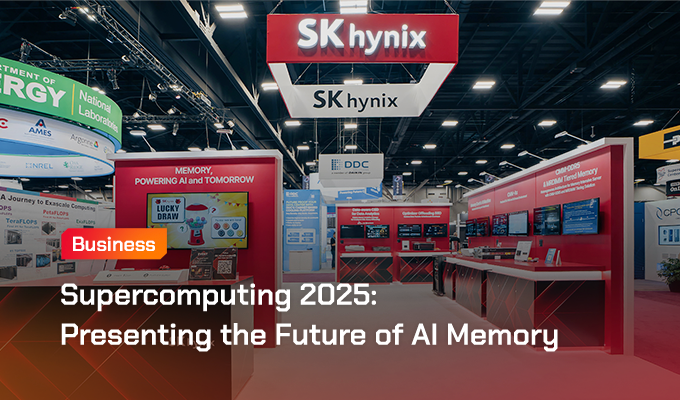Driving key technologies, intertwined with industries across the world, and an essential part of the AI era—semiconductors are integral to daily life. This fifth episode in the Semiconductor 101 series explores in detail why semiconductors are crucial for shaping modern society. The article also delves into why SK hynix is adapting its approach in the AI era and examines the sweeping influence of the semiconductor industry on the global economy.
![]()
Why does the world need semiconductor memory?
Semiconductor memory is indispensable for modern technology, enabling efficient data storage and processing across a variety of devices. To gain a better understanding of semiconductor memory’s importance, let’s picture how its absence would impact some areas of life.
![]()
A world without semiconductor memory would be like stepping back in time
Work
Without semiconductor memory, workers would find tasks that once could be finished in a day would take weeks or even months to complete. Computers would be painfully slow and inefficient —making opening and saving files a chore—and offer significantly reduced storage capacity. Multitasking would also be inefficient, with noticeable delays when switching between applications like Word documents and web browsers.
Other essential business applications such as video conferencing, cloud-based software, and messaging tools would be unreliable and costly, hindering collaboration and presenting huge obstacles to remote workers.
Digital Entertainment
People may struggle to fill their evenings and weekends as the entertainment on offer becomes severely limited. Online activities would be time-consuming or almost impossible without semiconductor memory, which enables networking equipment to manage and route data. Social media would be unrecognizable, as users would be unable to instantly share photos and videos. Streaming, gaming, and cloud services would also be unusable without fast and scalable storage solutions. Smartphones would not exist in their current form either, as high-performance and efficient memory is key to the functionality, compact size, and battery life of modern phones.
Banking & Finance
Financial transactions would look very different in a world without semiconductor memory. It would be necessary to make frequent trips to the bank, as app-based transactions would be impossible. This would affect personal finances and the broader economy.
Why is semiconductor memory crucial for the AI era?
In the AI era, semiconductor memory plays a key role in ensuring the smooth operation of AI applications. Today’s AI systems are performing advanced tasks such as image generation and problem solving which require significant data processing capabilities. Moreover, as these AI tools require ever-growing amounts of data to continue their evolution, there is a pressing need to manage this explosion of data. That’s where semiconductor memory comes in.
![]()
Semiconductor memory offers several key features which support the smooth operation of AI
High-performance memory is essential for data storage, retrieval, and processing, enabling technologies to keep pace with the rapid rate of data generation. Let’s break down some of the reasons why semiconductor memory is essential in the age of AI.
- Rapid Data Processing: AI systems must rapidly process vast amounts of data to make real-time decisions. Semiconductor memory supports this process by enabling fast data access and storage.
- AI Training Support: AI applications are trained on large datasets to improve their performance. Memory products with high capacity and bandwidth can store and manage these datasets. Moreover, the rapid read/write capabilities of memory solutions can accelerate AI training, making AI systems more efficient.
- Energy Efficiency: AI applications are resource intensive. Semiconductor memory helps reduce power consumption, making them more sustainable. Edge devices1, such as smart sensors and mobile AI processors, depend on energy-efficient semiconductor memory to perform tasks like real-time image recognition while conserving battery life.
As AI continues to evolve and integrate into various technologies, semiconductor memory remains the key to unlocking its full potential.
Why is HBM an essential product for AI?
Featuring stacked DRAM2 chips, High Bandwidth Memory (HBM) is an ultra-fast memory technology which has become crucial in the age of AI. Combining high performance with low-power consumption, HBM can efficiently handle the growing demands of AI systems.
![]()
Combining high performance with low-power consumption, HBM is an essential AI memory product
To illustrate some of the benefits of HBM for AI compared to other DRAM products, think of it as an upgraded metro system that reduces passenger wait times at stops. Traditional DRAM chips have a limited number of data paths, akin to station entrances and exits, which are prone to bottlenecks in the data-centric AI era.
Meanwhile, HBM features significantly more data paths which run vertically to support the smooth and rapid passage of data, just like passengers freely passing through a station with numerous entrances and exits. HBM’s ability to minimize delays, or latency, is key in AI systems which need real-time data access to perform tasks such as deep learning.
As touched upon in the previous question, AI systems handle massive datasets and complex computations. HBM supports these tasks by enabling swift and efficient data processing, making it ideal for AI training. For example, SK hynix’s world’s best-performing 12-layer HBM3E offers industry-leading data processing speeds of 1.18 terabytes (TB) per second.
In addition, HBM is optimized for supporting parallel processing in AI systems due to its high bandwidth. As it offers high performance with low-power consumption, HBM also enables AI systems to operate efficiently, particularly in data centers and edge computing devices.
Why does SK hynix need to expand its semiconductor production capacity?
Today, phones instantly recognize faces, autonomous cars cruise down highways, and smart fridges can place orders for food. These developments are largely thanks to technologies such as AI, 5G, and Internet of Things (IoT) devices, which all require high-performance memory products. Moreover, the rapid growth of these and other advanced technologies is further heightening memory demand.
![]()
The number of AI users is forecast to grow rapidly, heightening demand for semiconductor memory
Looking at the AI market alone, the number of AI users is projected to grow from almost 255 million in 2023 to around 730 million by 20303. In response to this changing technological landscape and resultant rising demand for memory, SK hynix is ramping up its production capacity. The company currently operates four production facilities in its home country of South Korea and plans to build two additional domestic facilities in the future, namely:
- The Yongin semiconductor cluster which will boost the company’s production of AI memory
- A fabrication facility (fab) in Cheongju which will produce next-generation DRAM products, including HBM
While it may seem straightforward to simply build new manufacturing facilities to increase production, there are other aspects to consider. For example, there are often challenges associated with commercializing innovations through mass production.
SK hynix is adept in this area, as the company has a long history of transitioning innovations from the R&D stage through to high-volume manufacturing, particularly with DRAM and NAND flash4. A recent example of this occurred in March 2024, when the company successfully mass-produced its 8-layer HBM3E through close client collaboration and enhancements in product design.
Why does the semiconductor industry have so much impact on the global economy?
![]()
The value of the semiconductor market is greater than the GDP of numerous countries
Semiconductors are essential components in a multitude of electronic devices and are driving technological advancements, making the industry a cornerstone of the global economy. In 2023, the semiconductor market was valued at around 611 billion USD, greater than the GDP of Singapore. However, the full extent of the semiconductor sector’s impact on the global economy can only be understood when looking at some of the industries fueled by these chips.
The consumer electronics market, which is valued at around 950 billion USD, relies heavily on semiconductors. The market’s size is emphasized by the fact that global smartphone subscriptions have surpassed 6.9 billion.
The telecommunications sector, including the expected trillion-dollar 5G market, also depends on semiconductors along with the automotive and healthcare industries. As previously mentioned, semiconductors are also key to advanced technologies such as AI, 5G, and IoT, highlighting their ubiquity in a wide range of high-value technology markets.
While it has been established that the semiconductor sector is a multi-billion-dollar industry which creates immense direct revenue, it also contributes to the economy in other forms. In particular, the sector employs people across the world in roles such as R&D, supply chain management, and manufacturing. By 2030, an estimated 3 million employees will be needed in the sector, highlighting its impact on jobs markets worldwide.
Exploring semiconductor manufacturing in more detail, production is concentrated in East Asian countries such as Taiwan and South Korea. Slowdowns in production which contributed to global chip shortages throughout the years have further highlighted the sector’s strategic importance to numerous industries across the world.
Looking ahead, the semiconductor industry’s impact on the global economy will only continue to grow as the sector itself, and others which rely on chips, expand in the future.
1Edge: The boundary of a network where data is generated and processed locally on devices or sensors, rather than being transmitted to a centralized data center.
2Dynamic Random-Access Memory (DRAM): A type of short-term computer memory that stores data temporarily while a device is on, losing information when the power is turned off.
3Statista, “Generative artificial intelligence (AI)” report (2024)
4NAND Flash: A long-term storage technology that retains data even when the power is off, commonly used in USB drives and memory cards.
The final episode of the Semiconductor 101 series will explore “how” semiconductors are made and provide insights on launching and advancing a career in this dynamic industry.
Read more articles from the Semiconductor 101 series







